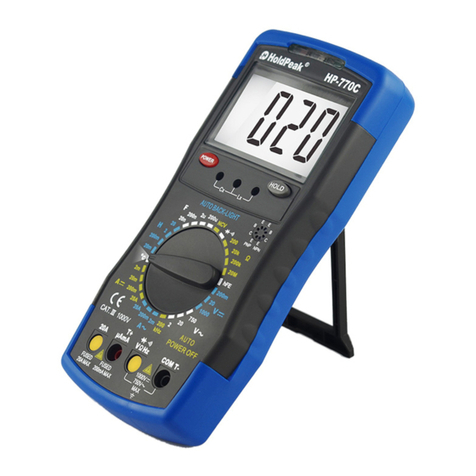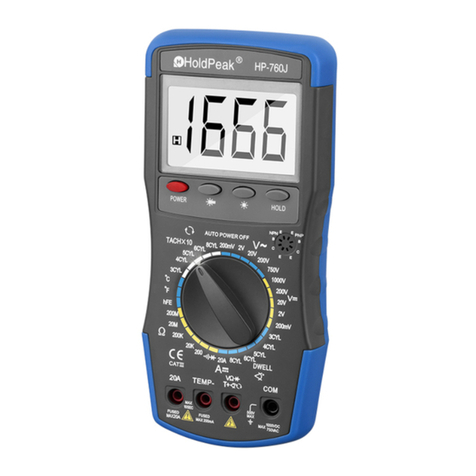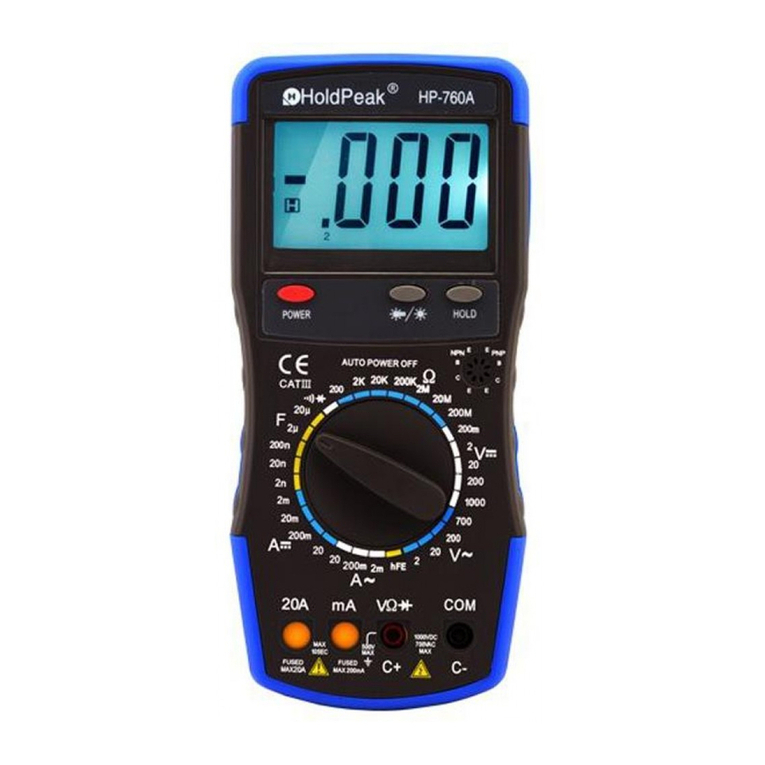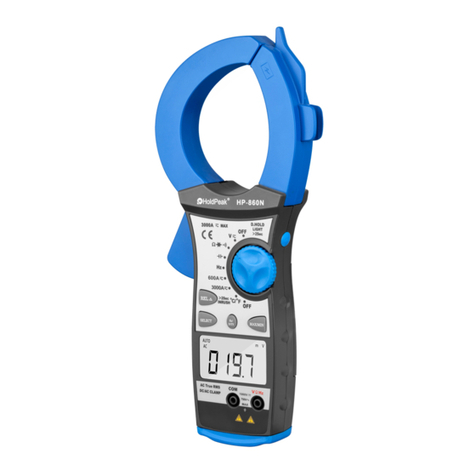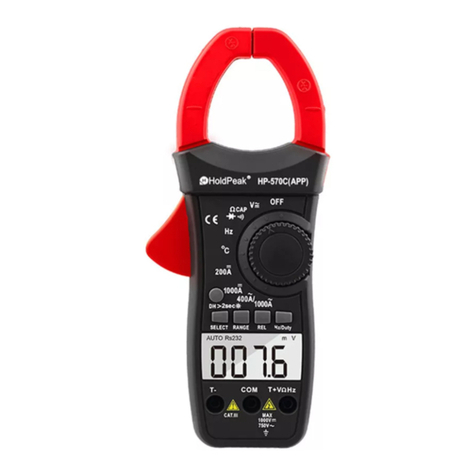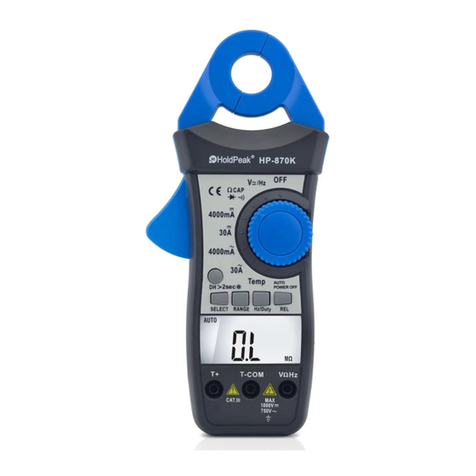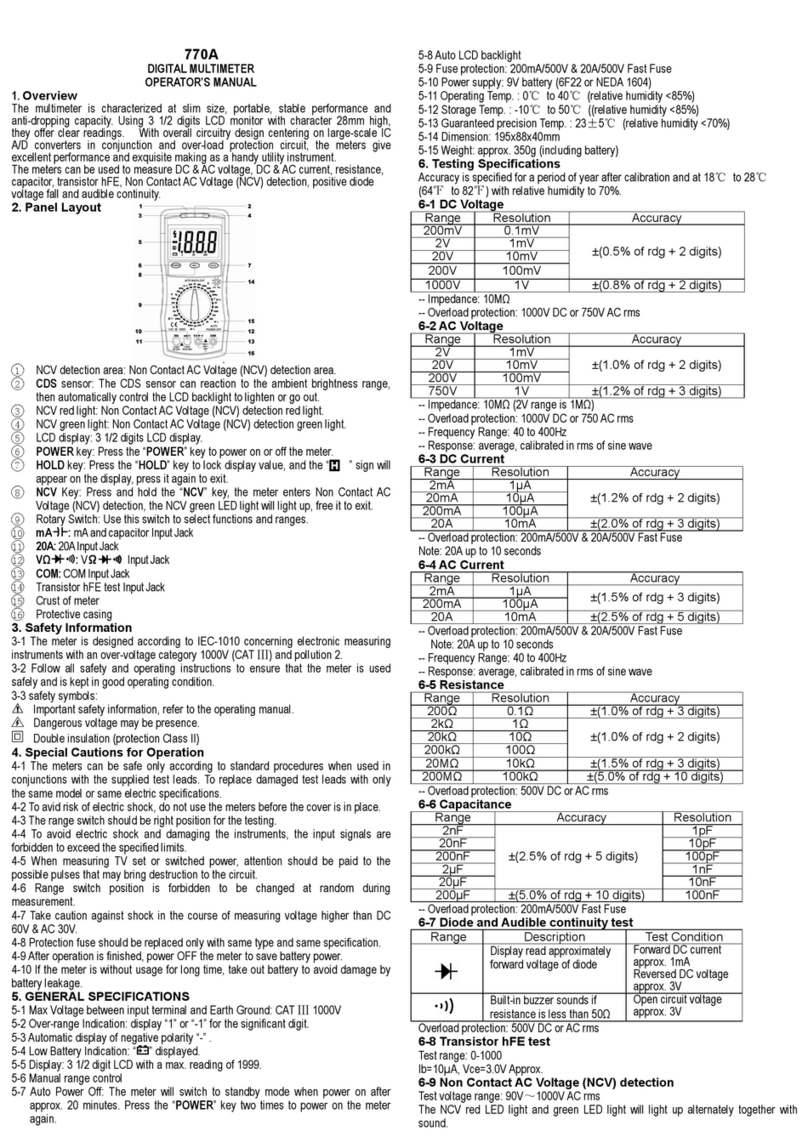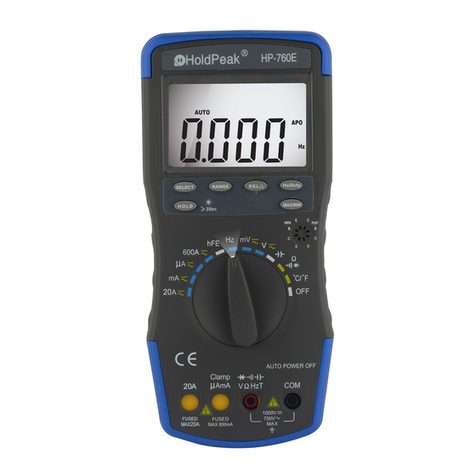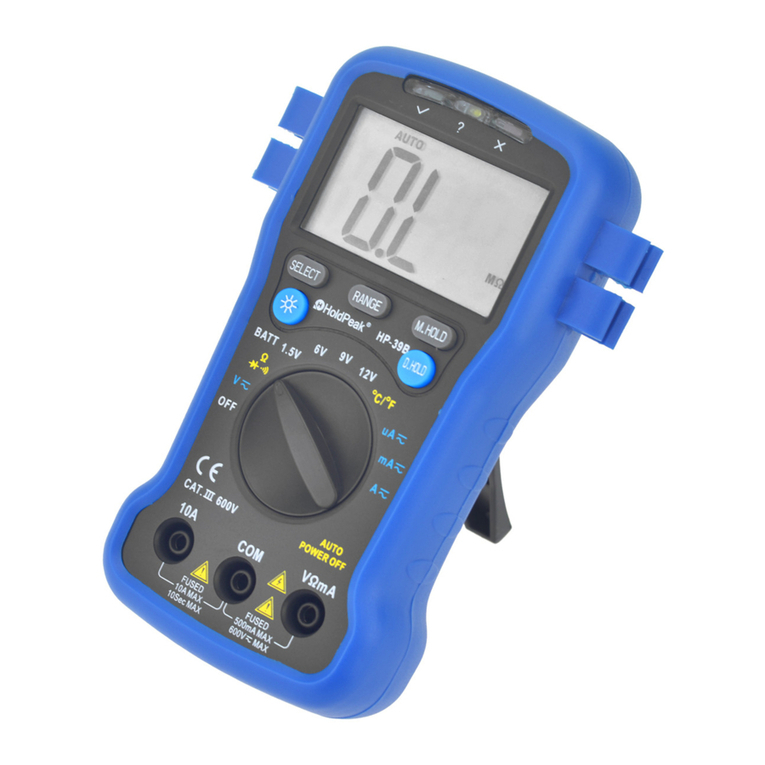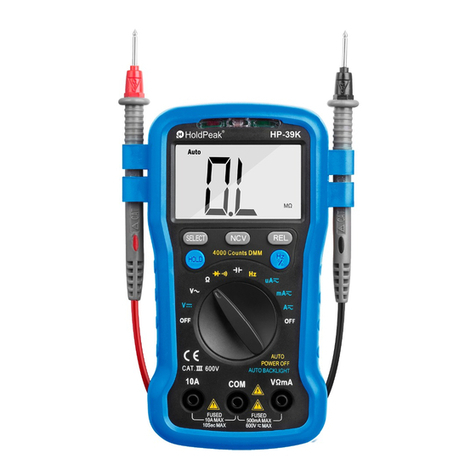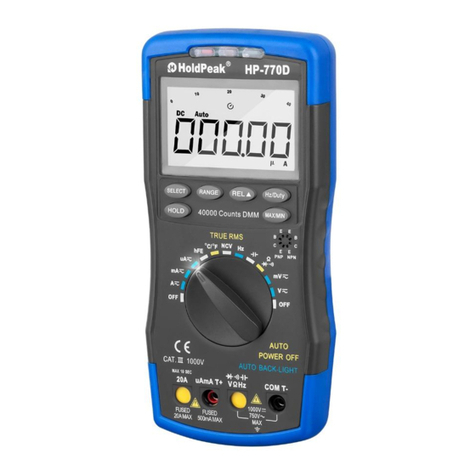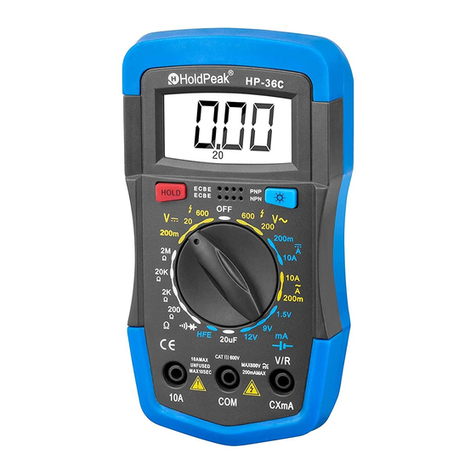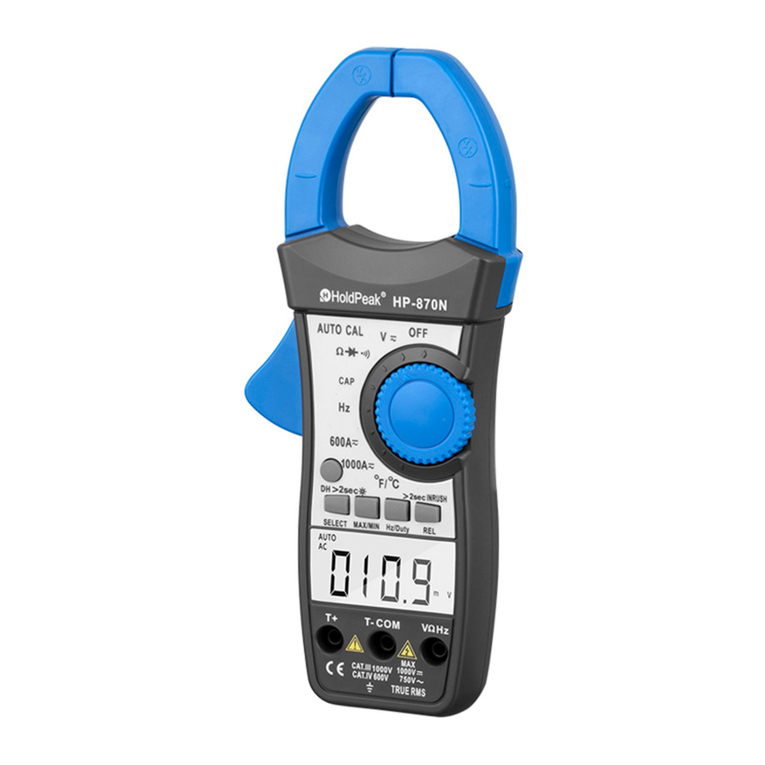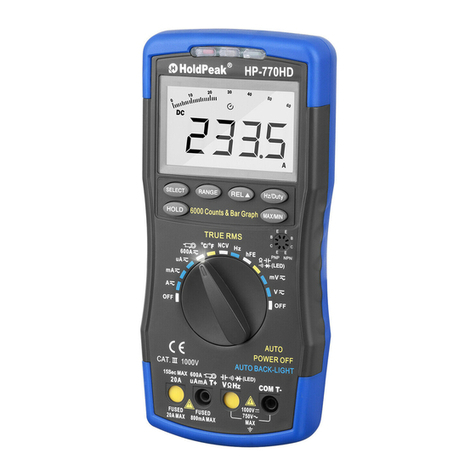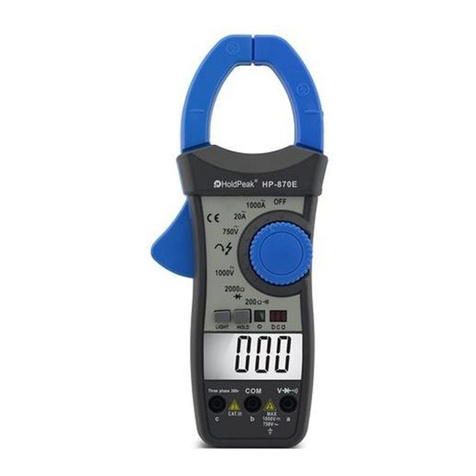Overload protection: DC/AC PEAK 15V
Battery voltage: 1.5V~12V
7. OPERATING INSTRUCTIONS
7-1 Measuring DC Voltage
7-1-1 Connect the black test lead to COM jack and the red to VΩHz jack.
7-1-2 Set the rotary switch at the desired V range position.
7-1-3 Connect test leads across the source or load under measurement.
7-1-4 You can get reading from LCD. The polarity of the red lead connection will be
indicated along with the voltage value.
NOTE:
1. When the value scale to be measured is unknown beforehand, set the range
selector at the highest position.
2. When only „OL‟ is displayed, it indicates over-range situation and the higher
range has to be selected.
3. “ ” means you can‟t input the voltage more than 1000V, it‟s possible to show
higher voltage, but it may destroy the inner circuit or pose a shock.
4. Be cautious against shock when measuring high Voltage.
7-2 Measuring AC Voltage
7-2-1 Connect the black test lead to COM jack and the red to VΩHz jack.
7-2-2 Set the rotary switch at the desired V~ range position.
7-2-3 Connect test leads across the source or load under measurement.
7-2-4 You can get reading from LCD.
NOTE:
1. When the value scale to be measured is unknown beforehand, set the range
selector at the highest position.
2. When only „OL‟ is displayed, it indicates over-range situation and the higher
range has to be selected.
3. “ ” means you can‟t input the voltage more than 750V, it‟s possible to show
higher voltage, but it may destroy the inner circuit or pose a shock.
4. Be cautious against shock when measuring high Voltage.
7-3 Measuring DC & AC Current
7-3-1 Connect the black test lead to COM jack and the red to the μAmA jack for a
maximum 600mA current , for a maximum 6A or 10A current, move the red lead to
the 10A jack.
7-3-2 Set the rotary switch at the desired uA & mA & 10A range position, it shows
symbol for testing DC current, if you want to test AC current, push „select‟ button
switch.
7-3-3 Connect test leads in series with the load under measurement.
7-3-4 You can get reading from LCD. The polarity of the red lead connection will be
indicated along with the DC current value.
NOTE:
1. When the value scale to be measured is unknown beforehand, set the range
selector at the highest position.
2. When only „OL‟ is displayed, it indicates over-range situation and the higher
range has to be selected.
3. “ ” means the socket mA‟s maximum current is 600mA and 10A‟s maximum
current is 10A, over current will destroy the fuse.
7-4 Measuring Resistance
7-4-1 Connect the black test lead to COM jack and the red to VΩHz jack.
7-4-2 Set the rotary switch at the desired Ω range position.
7-4-3 Connect test leads across the resistance under measurement.
7-4-4 You can get reading from LCD.
NOTE:
1. When only „OL‟ is displayed, it indicates over-range situation and the higher
range has to be selected.
2. For measuring resistance above 1MΩ, the mete may take a few seconds to get
stable reading.
3. When the input is not connected, i.e. at open circuit, the figure „OL‟ will be
displayed for the over-range condition.
4. When checking in-circuit resistance, be sure the circuit under test has all power
removed and that all capacitors have been discharged fully.
5. the value scale to be measured is unknown beforehand, set the range selector
at the highest position.
7-5 Measuring Capacitor
7-5-1 Connect the black test lead to COM jack and the red to -II-jack.
7-5-2 Set the rotary switch at the desired “-II-”range position.
7-5-3 Before inserting capacitor under measurement into capacitance testing
socket, be sure that the capacitor has been discharged fully.
7-5-4 You can get reading from LCD.
Caution:
a) Capacitors should be discharged before being tested.
b) When testing large capacitance, it will take longer time before the
final indication(For 1uF~99.99mF range, it will take about 4~7
seconds).
c) When testing small capacitance(≤1uF), to assur the
measurement accuracy, first press "REL", then go on measureing.
Max.input over-load: 250V rms<10sec
7-6 Measuring Frequency
7-6-1 Connect the black test lead to COM jack and the red to Hz jack.
7-6-2 Set the rotary switch at the Hz range position.
7-6-3 Connect test leads across the source or load under measurement.
7-6-4 You can get a reading from LCD.
7-7 Temperature measurement
7-7-1 Connect the black test lead of the sensor to T- socket and the red test
lead to the "T+" socket.
7-7-2 Set the selector switch to "℃/℉" position.
7-7-3 Put the sensor probe into the temperasure field under measurement.
7-7-4 Read the result from the LCD panel.
NOTE: Max.input over-load: 250V rms<10sec
A. The temperature function shows the random number at ordinary times, must
insert the thermocouple in temperature test hole while examining temperature.
B. This meter inclosure WRNM-010 type contact thermocouple limit
temperature is 250 ℃(300 ℃shortly ) ;
C. Please don't change the thermocouple at will , otherwise we can't guarantee
to measure accuracy ; Please don‟t importing the voltage in the temperature
function.
D. Please use special probe for test high temperature.
7-8 Diode Testing
7-8-1 Connect the black test lead to COM jack and the red to jack. (the polarity
of red lead is „+‟)
7-8-2 Set the rotary switch at the Ω range position, push „SELECT‟ button
switch until symbol of is displayed on LCD.
7-8-3 Connect the red lead to the anode and the black lead to the cathode of the
diode under testing.
7-8-4 You can get a reading from LCD.
NOTE:
1. The meter will show approximate forward voltage drop of the diode.
2. If the lead connections is reversed, only „OL‟ will be displayed.
7-9 Continuity Testing
7-9-1 Connect the black test lead to COM jack and the red to jack.
7-9-2 Set the rotary switch at the Ω range position, push „SELECT‟ button
switch until symbol of is displayed on LCD.
7-9-3 Connect test leads across two points of the circuit under testing.
7-9-4 If continuity exists (i.e. resistance less than about 50Ω), buzzer will sound.
NOTE:
If the input open circuit, the figure „OL‟ will be displayed.
Circuit under measurement should be power-off,
otherwise, any load signal can make the buzzer sound.
7-10 Battery Power Test
7-10-1 Set the FUNCTION switch to the “ ” range
7-10-2 Connect the BLACK test lead to “COM” jack and the RED test lead to the
“VΩ” jack.
7-10-3 Connect the BLACK test lead to the cathode and the RED test lead to the
anode of the battery under testing.
7-10-4 The LCD dispay Voltage of battery by testing with load
8. Maintenance
8-1 Before attempting to remove the battery door or open the case, be sure that
test leads have been disconnected from measurement circuit top avoid electric
shock hazard.
8-2 To avoid electrical shock, remove test leads from measurement circuits before
replacing the fuse. For protection against fire, replace fuses only with specified
ratings: F-800mA/1000V fuse or F-10A/1000V
8-3 Your must replace the test leads if the lead is exposed, and should adopt the
leads with the same specifications as origin.
8-4 Use only moist fabric or small amount of detergent but not chemical solution for
cleaning.
8-5 Do not use the meter before the back cover is properly closed and screw
secured. Upon any abnormality, stop operation immediately and send the meter
for maintenance.
8-6 Please take out the battery when not using for a long time.
9. Accessories
[1] Test Leads: electric rating 1000V 10A
[2] Fuse: F-800mA/1000V F-10A/1000V
[3] „K‟ type Thermocouple
[4] Operator‟s Manual

